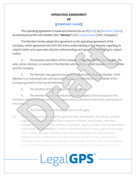Withdrawal Agreements Explained: Essential Guide
Navigating legal matters can often be daunting, especially when it involves something as important as a withdrawal agreement. If you're a business...
8 min read
LegalGPS : Jul. 25, 2024
As a business owner, you've probably dealt with a variety of contracts. But have you ever needed to change a part of them after signing? Well, that's where a contract addendum comes in handy. This guide will acquaint you with everything you need to know about this important legal tool.


Contract Addendum Template
Download our Contract Addendum Template to make modifications or additions to existing agreements. Customize it to fit your contract changes today!
Trusted by 1,000+ businesses to safeguard their LLCs.
A contract addendum is a separate, additional document that sets modifications to an existing contract. Instead of rewriting the entire agreement, it allows both parties to agree upon changes that will then be incorporated. This makes an addendum an incredibly useful tool for smoothly accommodating business changes or unexpected circumstances.
An effective addendum comprises several key elements:
1. Parties to the contract: Makes it clear who is agreeing to the addendum, aligning with the original contract.
2. Effective Date: Indicates when the changes will apply. Ideally, it should coincide with the signing date of the addendum.
3. Contract Changes: Clearly names which sections or terms of the original contract are to be changed. These changes should be as clear and easily understood as possible.
4. Signatures: All involved parties must sign the addendum to validate it.
Addendums and amendments often get mixed up. Briefly put, while both alter original contracts, amendments tend to rewrite or abolish contract terms while addendums stipulate additional instructions that work alongside the current terms For example, a change to the timeline of a project would be an amendment. If you wanted to change the payment terms from monthly to quarterly, this would be an addendum.
The bottom line is that addendums are not the same as amendments. If you’re looking to rewrite or abolish your contract, then an amendment is a better option than an addendum.
Any changes in a property transaction, including price adjustments, changes in closing dates, or property inspection results, are handled with real estate addendums.
Should the financing conditions in a contract alter, these additions come into play. If you were to secure a lower interest rate, for example, this would be an addendum. Insurance Addendums Changes in property insurance—such as policy changes or cancellation of coverage—are handled with these additions to the contract.
Specific for real estate transactions, these additions apply if a seller needs to complete specified improvements If the property is in poor condition, for example, this would be an addendum. If you wanted to remove a wall or renovate a room, these are handled with home inspection contingency addendums.
These relate to changes unique to various industries, such as construction delays in a building contract If a contract has an addendum, it’s usually located near the end of the document. The addendum will be clearly marked with a heading and often highlighted in yellow or red.
Crafting an addendum requires clarity, precision, and some legalese knowledge. But don't worry, we've created a step-by-step guide to simplify the task.
1. Review the Original Contract: Understand the specific terms you're altering.
2. Draft the Addendum: Agree upon changes with the other party in writing and list them in the order of their appearance in the original contract.
3. Seek Legal Counsel: Have an expert review your draft to ensure legal soundness.
4. Gain Approval: Have all parties sign the addendum, and voila! The contract has been successfully modified.
Beyond these steps, remember: clarity is key. State your changes explicitly and avoid any ambiguities so your addendum can efficiently serve its purpose. If you want to draft an addendum yourself, use a legal contract template. They're often available online and can be customized for your needs.
The addition of an addendum can legally alter a contract. For it to be binding, all sides must agree and sign it. This agreement signifies their intent to adhere to the new terms.
With legal territory, it's always wise to pursue due diligence. Take time to understand how a contract addendum may affect your business agreements and seek professional counsel if necessary.
"Can I use a contract addendum to change any term of a contract?"
Yes, as long as all parties involved agree to the changes.
"Should the contract addendum be of the same form as the original contract?"
Although not strictly necessary, it's advisable to echo the form and language of the original contract in an addendum for consistency and clarity.
"What happens if a party does not agree to the contract addendum?"
If agreement can't be reached, the contract remains as initially agreed, unless another form of modification is implemented.
Contracts are the backbone of business relationships, and an addendum gives you the flexibility to adapt these agreements as needed. Remember, when writing an addendum: be clear, be precise, and don't be shy about seeking professional advice. By integrating these principles, you'll master the art of contract modifications, ensuring a smoother sail in your business endeavors.
For further help, check out our contract templates that can help guide you on your journey to solid and adaptative business agreement.
Before picking up your pen, you need to be clear about what changes will be incorporated. Reread your contract and pinpoint the areas that need modification. This could be anything from addressing an overlooked detail to adjusting the duration of the contract.
When you’re ready to draft, write down each change and what it means in plain language. This will help you remember the details of your agreement in the future. If there are multiple modifications, make sure to keep them separate so they can be easily identified later on.
Having identified the alterations, let's plunge into the drafting process.
The addendum should begin with a title that mirrors the formatting of the original contract. For example, if you're modifying a "Supply Agreement Contract," your heading might be, "Addendum to the Supply Agreement Contract. The addendum should also include the date that it was signed by both parties.
This will help you keep track of when the alterations went into effect and who approved them. The title and date are followed by a short paragraph explaining what the document is and why it's being used.
Following the title, the addendum should mention the names of the parties as they appear in the original contract. Include the date of the original agreement too for reference and easier tracking.
For example , "Addendum to the Supply Agreement Contract between [name of party] and [name of other party]." 3. Making the Alterations Once you've identified the parties, it's time to get down to business. The addendum should contain all of your changes and additions in numbered paragraphs with short headings.


Legal GPS Pro
Protect your business with our complete legal subscription service, designed by top startup attorneys.
Now comes the detailed part. Each change you wish to make should be specified in this section.
For example, let's imagine the original contract states, "Payment of $500 should be provided upon completion of the service." You and the other party have now decided the payment would be $500 but in two installments. This change of term in the addendum might read something like this:
"The payment terms in the original contract are hereby amended. As opposed to a lump sum upon completion of the service, a payment of $250 should be made at the onset of the contract and the remaining $250 upon completion."
You get the idea. Simple, clear sentences that get straight to the point. The reason for this is simple. If you’re going to add something, it should be clear what the new element is and why it’s being added.
You can think of an addendum as a way to clarify the original contract or offer additional information that wasn’t available when the contract was drafted. This could include things like changes in price, terms or even delivery dates for goods or services.
Get Your Contract Addendum Template
with a Legal GPS Subscription
As you describe the changes, be as clear and detailed as possible. Reference clauses or sections from the original contract that the addendum is modifying. Clearly state if the term is being substituted, deleted, or added. For example if you’re adding a new term, state that the original contract is being modified by the following terms: “The seller hereby warrants that all products are free of defects in material and workmanship, and will be delivered to the buyer by [date].” If you’re deleting a clause, say something like this: “The services described in paragraph 2 are excluded from this agreement.”
Unclear language or vagueness might lead to misunderstanding or confusion in the future. Therefore, precision is incredibly crucial.
Once the addendum is drafted, it's time to get agreement from all parties. Ensure each party reads, understands, and then signs the addendum. This helps protect all parties if disputes arise. If you have an email chain where everyone agrees on the changes, that's a good way to document.
Keep records of all changes as you implement changes or additions, keep track of them in a separate file and update your contract accordingly. This will help prevent confusion down the road and make it easier for both parties to see what has changed.
After everyone has signed, attach the addendum to the contract. Now, you have successfully amended your contract, paving the way for a smoother and more transparent transaction. This achievement not only solidifies the agreement between all parties involved but also sets a precedent for clear communication and mutual understanding.
By incorporating the addendum into the contract, you have taken a proactive step towards ensuring that all modifications and additions are documented and legally binding. This attention to detail and commitment to clarity will serve as a strong foundation for a successful and harmonious business relationship. Congratulations on navigating the complexities of contract modifications with precision and professionalism.

Contract Addendum Template
Download our Contract Addendum Template to make modifications or additions to existing agreements. Customize it to fit your contract changes today!
Trusted by 1,000+ businesses to safeguard their LLCs.
With the basic steps covered, let’s now turn to some common mistakes made in addendums and how to avoid them.
1. Lack of Specific Details: A crucial part of writing an addendum is ensuring that all changes to be made are specifically and comprehensively described. To make sure your addendum is clear and concise, avoid legal jargon, and stick to plain language.
2. Not Getting Agreement from all parties: Before drafting an addendum, all parties must agree to the changes. Failing to do so could lead to legal issues down the line.
3. Not Including a Time Frame: It’s crucial to include a time frame for completing your project in the addendum. If no timeline is specified, it may be difficult to hold someone accountable for finishing work by a certain date.
4. Not Including a Budget: One of the most crucial parts of any project is the budget. It’s not enough to simply say that money will be exchanged; you need to specify how much each party will pay for certain tasks, materials, and services.
5. Failing to Include Liability Clauses: As with any contract, it’s important for both parties to agree on who is responsible for what before signing off on an addendum.
Our template is designed to help you create an addendum that will work for your project. It includes everything you need, from the basics like names and contact information to more specific items like budget and timeline. Click here to get started!
There you have it! You now know the ins and outs of drafting an addendum. Remember, it’s vital to keep tabs on your business contracts since they form the core of your business dealings. Knowing how to draft an addendum will enable you to modify these contracts as your business evolves, ensuring your agreements always well-serve and protect you. Now, with your newly mastered skill, be ready to take on any contract changes that come your way with confidence.
Get Legal GPS's Contract Addendum Template Now
The biggest question now is, "Do I need a business lawyer?” For most businesses and in most cases, you don't need a lawyer to start your business. Instead, many business owners rely on Legal GPS Pro to help with legal issues.
Legal GPS Pro is your All-In-One Legal Toolkit for Businesses. Developed by top startup attorneys, Pro gives you access to 100+ expertly crafted templates including operating agreements, NDAs, and service agreements, and an interactive platform. All designed to protect your company and set it up for lasting success.

Legal GPS Pro
Protect your business with our complete legal subscription service, designed by top startup attorneys.
|
Premium Template
Single-use Template |
Legal GPS Pro
Unlimited Access, Best Value |
|
|
| Choose Template | Learn More |
| Trusted by 1000+ businesses | |
Table of Contents

Navigating legal matters can often be daunting, especially when it involves something as important as a withdrawal agreement. If you're a business...

Have you ever heard of the term "assumption agreement" and wondered what it meant? You're not alone. To understand assumption agreements, we need to...

Navigating the world of business transactions can, at times, feel overwhelming. When selling, one of the crucial documents you may come across is a ...